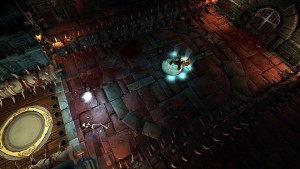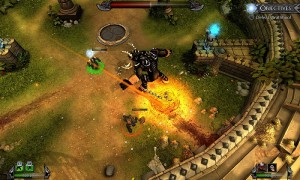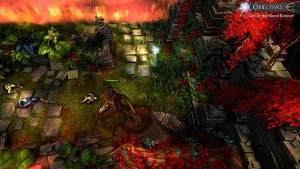By Brad Jones
[divider]Having played the first few levels of Forced earlier in the day, I thought I knew what to expect when I teamed up with sound designer Jesper Kristiansen to see what co-op had to offer. Playing alone, I liked the game well enough—it offered a fresh mix of elements that I was familiar with and there was something compelling about the core gameplay, an engaging and constantly changing mix of combat and puzzle-solving.
However, there was something missing. Something I couldn’t quite place my finger on. After playing one level co-operatively with Jesper, I soon realized that this element was another player. Forced comes to life when you’re playing with someone else. Mechanics that seemed novel in single-player take on new life in co-op, a prime example of this being the Orb that guides you through the game and comes into play in many of its puzzles. At the press of a button, the Orb will travel in a straight line to your current location, and can be used to trigger switches that it passes over. Playing alone, it’s a neat way of linking puzzle to your movement, allowing you to fight whilst you solve and keeping things action-oriented. However, in multiplayer, since you all have the same ability to command the Orb, there’s a great deal of potential for interesting ways that you can work together and steer the Orb.
 Having not anticipated how this shared control of the Orb would change the game, I found my confidence in my abilities fall apart a few seconds into the first level. Far from the measured, steady pace of my single player efforts, Forced became a hectic blur of combat, puzzles and the constant worry that I wasn’t pulling my weight on the team—and it was brilliant.
Having not anticipated how this shared control of the Orb would change the game, I found my confidence in my abilities fall apart a few seconds into the first level. Far from the measured, steady pace of my single player efforts, Forced became a hectic blur of combat, puzzles and the constant worry that I wasn’t pulling my weight on the team—and it was brilliant.
In single player, my main impetus to keep playing was that familiar RPG feeling of beefing up your character. Here, your method of character advancement resembles a cross between a familiar RPG skill tree and an FPS perk system, where three crystals can be had for accomplishing various goals in a level, and accruing a certain amount will unlock a particular skill. It’s simple but it works well, although it did feel a little thin until I saw how it fit into co-op. Here, it looked far more comfortable in a supporting role, as the moment-to-moment gameplay, proving far more compelling with another player, did most of the heavy lifting in maintaining my interest.
Having just about gotten used to how manoeuvring the orb worked with two players—admittedly having to start from scratch after I walked into a laser beam and found myself splattered across the ground—we reached the end of the level. Here, there were two flags; one would end the level, whereas solving the puzzle require to reach the other would earn us an extra crystal and help us level up faster. The game is filled with this type of extra content designed to keep players on their toes. However, given that I hadn’t exactly covered myself in glory in the puzzles up until this point, Jesper suggested we might just go for the first flag. I agreed.
 ‘So, this was more of a puzzle-y level,’ Jesper says to me after we’re back in the main hub. ‘Ready for some action?’ The variety in this game from level to level is very impressive. It’s reminiscent of a Mario platformer, in that a major game mechanic might span a set of levels but each one feels like a self-contained experience with its own twist on that idea. Jesper moves his character over to the final door in the hallway we are both in. ‘This one is fun,’ he says. ‘The last challenge of a chamber is always something special. Since you actually unlock the boss without completing the last challenge in a chamber, we usually make them a bit harder.’ I had an inkling that I was, once again, going to let Jesper down.
‘So, this was more of a puzzle-y level,’ Jesper says to me after we’re back in the main hub. ‘Ready for some action?’ The variety in this game from level to level is very impressive. It’s reminiscent of a Mario platformer, in that a major game mechanic might span a set of levels but each one feels like a self-contained experience with its own twist on that idea. Jesper moves his character over to the final door in the hallway we are both in. ‘This one is fun,’ he says. ‘The last challenge of a chamber is always something special. Since you actually unlock the boss without completing the last challenge in a chamber, we usually make them a bit harder.’ I had an inkling that I was, once again, going to let Jesper down.
The level took the form of a roughly square arena with a worrisome hole in the middle. Soon, a crystal emerged from this hole and started firing a continuous laser beam whilst rotating. This beam was an instant death should you stray into it, and having fallen foul of a similar trap in the level previous, you might think that I would have learnt my lesson. Sadly I had not. To further complicate things, a host of enemies were attacking us on foot.
It took me longer than it should have to figure out exactly what our strategy should have been to put this one to bed. Calling the orb through the crystal caused it to take one hit, so having one player on either side of the enemy at all times would be the easiest way to have a consistent back and forth and keep dealing out damage. However, for most of my time in the level I was more concerned with staying alive, something that I wasn’t very successful in doing. Whilst we nearly managed to grind out a victory, eventually we were both taken down and failed the level. I took this opportunity to ask Jesper a few questions about the game.
You may have heard that during the early stages of production of Forced, the team at BetaDwarf found themselves having to live and work together in order to cut down costs. ‘I was the first external person they brought in,’ says Jesper when asked about this time. ‘So while I didn’t sleep there myself, I was working out of the occupied classroom for a couple of months, and later from the house in the suburb of Karlslunde.’
I ask Jesper what it was like to enter into a group that was presumably rather tight-knit by this point. ‘Well it was kind of weird in the beginning. Also because I was about 10 years older than most of them,’ Jesper replied. ‘But we got along, and after a while, it wasn’t so strange. I also think, that having an external person come in, was a great excuse for them to ‘man up’ and be more businesslike about it – pushing it just a slight bit more towards a serious game dev production.’ As we are discussing Jesper’s place in the team, I can hear his handiwork in the background—the sound of enemies continuously attacking our corpses.
 The enemies in question are called Swarmers, and are a constant presence through the early stages of the game. ‘It basically dog sounds I fiddled around with,’ replies Jesper when I ask him how he made these sound effects. ‘And then humans, reversed and pitched down – to put it very simply.’ The Brawlers have an even more unlikely origin. ‘It’s actually a Spanish person reading a prayer.’ I certainly wouldn’t have guessed.
The enemies in question are called Swarmers, and are a constant presence through the early stages of the game. ‘It basically dog sounds I fiddled around with,’ replies Jesper when I ask him how he made these sound effects. ‘And then humans, reversed and pitched down – to put it very simply.’ The Brawlers have an even more unlikely origin. ‘It’s actually a Spanish person reading a prayer.’ I certainly wouldn’t have guessed.
We elect to try one last level. I am very keen to make up for my attempts up until this point. At the very beginning of the stage, there is a switch that requires us to stand on a platform for a certain length of time before it will open the gate in front of us. I suspect this will come into play again later. Once we are through the gate, we find ourselves under attack by a giant stone statue given life, which we cannot damage ourselves but can kill us fairly quickly. We run away and the statue makes chase. The first few sections of the level come fairly easily, until we reach a puzzle where we are besieged by normal enemies and the statue whilst we’re to set about solving it. I soon die, at which point Jesper goes back to a healing station to lick his wounds and wait for me to respawn. Once I’m back, we return to the puzzle, Jesper solves it and we head on to what must surely be the final section.
Here, disaster strikes. More stone statues, just as unkillable as the first, rise from the walls. They surround another time switch just like at the beginning of the level. We make an attempt to use the switch but there is simply too much going on and, much to my dismay, Jesper kicks the bucket. I am alone with the statues and various other beasties for the next thirty seconds. Having watched his tactics in a similar situation carefully, I attempt to head back to the healing station but find the route cut off. I am left with minimal health and it seems that all is lost.
 Thankfully, I am playing as the quickest of the four very different characters available, and so I start to form a new plan: run away until Jesper comes back. There are a lot of monsters in pursuit, but thankfully my character is manoeuvrable enough to keep ahead of the pack and, before I know it, Jesper is back. I return to him and, with our enemies struggling to keep up, we find ourselves with plenty of time to stand on the switch and finish the level. I am overjoyed that I didn’t ruin things.
Thankfully, I am playing as the quickest of the four very different characters available, and so I start to form a new plan: run away until Jesper comes back. There are a lot of monsters in pursuit, but thankfully my character is manoeuvrable enough to keep ahead of the pack and, before I know it, Jesper is back. I return to him and, with our enemies struggling to keep up, we find ourselves with plenty of time to stand on the switch and finish the level. I am overjoyed that I didn’t ruin things.
‘So, there you go. That’s Forced with two players. Of course, four is even more hectic.’ I can barely begin to imagine. I praise the restraint of the team in making bite-sized levels that keep things fresh and refrain from outstaying their welcome. ‘Yes, long enough to be exciting, but not so long, that you don’t want to do it again, when you fail.’ I ask Jesper if, having joined the team midway through production, he has seen a lot of change in the game. ‘Oh yes, very much. Originally it was supposed to be a Facebook game. I kid you not!’ Playing Forced in its current form it’s difficult to see how it could ever have been ‘casual game’ such as this. Yes, it’s got something of a party-game vibe, and the three-star challenges on each level has a superficial resemblance to Angry Birds et al., but Forced is far from the sort of game that you’d expect to play on Facebook.
 I ask Jesper if he thinks that Forced could have been made without crowdfunding. ‘I can’t say for certain, that Forced wouldn’t have happened without Kickstarter. But it would have been much more difficult,’ he replies. It gave us a break, when we needed it. We needed it a lot.’ Having played Forced with Jesper, I’m glad that BetaDwarf got that break. The game that they have made is really special—cribbing some of the best bits from modern online game design and action RPGs and making a multiplayer game that you can play in 15 minute bursts, but you’ll want to play for hours on end. If you’re looking for some of the same chaotic fun that you’ll find in a party game, but with a bit more meat on its bones, you’ll certainly want to give Forced a try—just make sure you give it a try in multiplayer.
I ask Jesper if he thinks that Forced could have been made without crowdfunding. ‘I can’t say for certain, that Forced wouldn’t have happened without Kickstarter. But it would have been much more difficult,’ he replies. It gave us a break, when we needed it. We needed it a lot.’ Having played Forced with Jesper, I’m glad that BetaDwarf got that break. The game that they have made is really special—cribbing some of the best bits from modern online game design and action RPGs and making a multiplayer game that you can play in 15 minute bursts, but you’ll want to play for hours on end. If you’re looking for some of the same chaotic fun that you’ll find in a party game, but with a bit more meat on its bones, you’ll certainly want to give Forced a try—just make sure you give it a try in multiplayer.
Game Info
Game : Forced
Developer : Beta Drawf Entertainment
Platforms : Win / Mac / Linux




